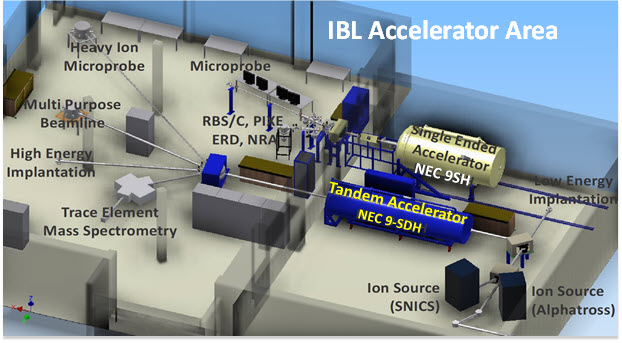Join your colleagues and stroll through the University of North Texas Ion Beam Lab. The SNEAP delegates will take the tour on Monday while the CAARI delegates will tour the lab either on Tuesday or Wednesday. The exact day will be determined at the conference check-in.
Buses will transport participants from the Conference Hotel to the UNT Student Union. A short walk to the UNT Physics Department and IBL. After the tour participants will be transported back to the hotel.
Due to the limited space all interested participants must sign up for the tour prior to the start of the conference. The lab tours are free.
UNT Ion Beam Laboratory (IBL)
The UNT-IBL is an internationally recognized laboratory for research and training in the field of ion beam applications.
The Accelerator Group occupies the entire basement floor in the Physics building and includes several excellent ion accelerators based experimental systems for analysis and modification of materials. The IBL contains four ion accelerators with dedicated beam lines for a number of ion beam modification and analysis techniques and atomic and nuclear physics research. The four accelerators include a 3 MV NEC tandem Pelletron® accelerator, a 3 MV NEC single ended Pelletron® accelerator, a 2.5 MV single-ended Van de Graaff accelerator, and a 200 keV Cockcroft-Walton accelerator, which allows for a wide range of ion energies from 10 keV to over 15 MeV.

Capital items along with the necessary support electronics, computers, etc. available in IBL include
3 MV Single Ended Accelerator and Associated Major Systems
NEC 9SH, 3 Million Volt Pelletron® Single Ended Accelerator with RF-gas Ion Source. Essen-tially any gaseous ion can be produced and accelerated to a terminal potential up to 3 MeV. Presently, there are three beam transport lines (a) general purpose line for Rutherford backscattering spectrometry (RBS) and ion Channeling, particle induced x-ray emission (PIXE) (b) Ion microbeam line for 3D elemental mapping/profiling using RBS, PIXE, Scanning transmission ion microscopy (STIM) and (c) large area (up to 3” diameter) electrically raster scanned ion implantation beamline. Major systems on this accelerator include:
- High Energy Focused Ion Beam Microprobe System: Magnetic Quadrupole Quadruplet focusing system for microPIXE, microRBS, STIM, microlithography.
- General Analysis Beamline: This beamline consists of beam defining slits, vacuum chamber, positioning stage, x-ray and particle detectors for broad beam applications of all the standard ion beam analysis techniques such as Rutherford Backscattering Spectrometry (RBS), Particle Induced X-ray Emission (PIXE), Elastic Recoil Detection (ERD) and Nuclear Reaction Analysis (NRA).
- Implant Beamline (not shown in Figure): This beamline is typically used for high energy implants of H and He into solid samples for solid state materials research.
3 MV Tandem Accelerator and Associated Major Systems
NEC 9SDH-2, 3 Million Volt Pelletron® Tandem Accelerator with two Sputter-Type Ion Sources and a Helium Ion Source. Essentially any element in the periodic table can be produced and accelerated to a terminal potential up to 3 MeV. Presently, there are four high-energy beam transport lines and one low-energy beam transport line taken from just the ion source. For the low-energy beam line, the ion energy can be varied from ~10-80 keV. Major systems available on the tandem accelerator include:
- Low Energy Ion Implantation Beam Line
- High Energy Ion Implantation Beam Line
- Multipurpose beam line with analysis techniques: RBS, PIXE, Elastic Recoil Detection (ERD), NRA, and broad-beam Single Event Upset (SEU) in integrated circuits.
